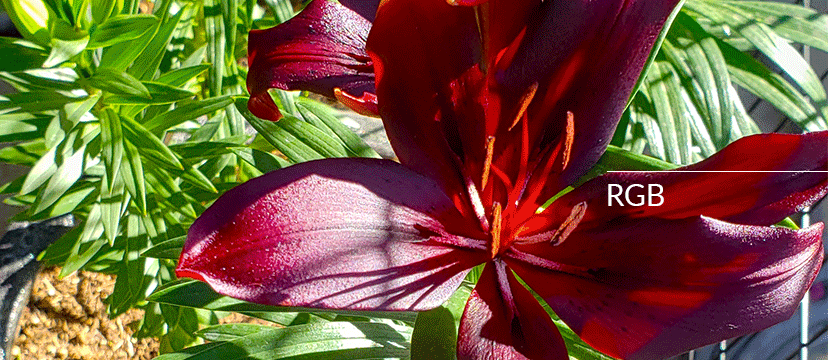Color Spaces and You: Why You Need to Change RGB to CMYK for Print
Written by UPrinting ● Published on September 25, 2023
If you’re reading this, chances are your artwork is RGB (red, green, blue). That’s okay if it’ll always be displayed on a screen. But if you want to print your design with the highest quality and sharpest images, you have to convert it first to CMYK (cyan, magenta, yellow, key/black). The reason for this is colors on a screen differ from those on printed materials. Screen colors are lit up, while printed colors rely on ink, making some colors appear slightly different. Proper proofing can ensure quality printed results. In this article, we go through the key differences between the two-color spaces and what it means for printing.

What’s the difference between RGB and CMYK?
The difference lies in how the two models create colors. RGB mixes varying intensities of light on digital screens, while CMYK mixes ink.
- • RGB is an additive color model, primarily used in electronic displays such as computer monitors, television screens, digital cameras, and smart phones. It uses light to blend colors on screens, getting brighter as more colors are added, resulting in white.
- • CMYK is a subtractive color model. Unlike RGB, CMYK colors create a spectrum by absorbing light rather than emitting it. It absorbs light, becoming darker with more ink, leading to black. The term "subtractive" comes from this process of subtracting brightness from white.
#ILoveUPrinting: What's the difference raster and vector images?
Why you should choose CMYK for prints and what happens if you don’t
The colors that shine vibrantly on our screens do so because of the RGB model, but when it's time to print that design onto paper, CMYK takes the lead. We asked UPrinting’s Senior Creative Director, Greg Simmons, why color models matter and what happens if you don’t convert from RGB to CMYK before printing.
“CMYK and RGB are inherently different—RGB is light-based and CMYK is ink on paper,” he explains. “To get a better idea of what will ultimately print, you should change your images to CMYK to see for yourself some of the subtle color shifts. Even though the change is on-screen—which is still digital/light—it will get you closer to envisioning the end result.”
What’s crucial with making the switch from RGB to CMYK is preserving color accuracy and getting consistent, repeatable results. If you don't convert RGB images to CMYK before printing, the printed colors may not match what you see on your screen. This discrepancy is due to the broader range of colors, or color gamut, that can be displayed by RGB devices compared to CMYK. Certain bright shades seen on a digital screen simply can't be reproduced with standard printing inks. In print speak, they are "out of the color gamut". Arcgel Hinggo, one of UPrinting’s Prepress Managers, expounds on the need to convert the color space once you decide to print your digital images: “Printing industry machines are built to recognize CMYK. If you don’t switch, that’s okay. Our prepress team will do it for you as it is literally impossible to print in RGB.” So when you print an RGB image, the printer will automatically convert it to CMYK using its in-built conversion process, which may not preserve the colors as you intended. This critical stage in the printing process determines how accurately your colors will appear on the finished product.
By converting to CMYK yourself, you can manage and adjust the colors to get as close as possible to the desired effect before printing. Some professional design software like Adobe Photoshop or Illustrator have tools for simulating how colors will look when printed in CMYK, allowing you to adjust your design accordingly to get the result that you’re looking for.
How do I change an image from RGB to CMYK?
Wondering if a photo is RGB or CMYK? By default, the images you’ll see on screens and on your phone are in RGB. If you download an image from the internet and plan to print it, you will need to convert it from RGB to CMYK to ensure the colors print accurately. Here’s a quick guide on the most popular design tools you can use:>
Adobe Photoshop:
- • Open your image in Photoshop.
- • Click on the 'Image' menu at the top of the screen.
- • Hover over 'Mode' in the dropdown menu.
- • Select 'CMYK Color'.
- • Save your image. It's recommended to save a new version of your CMYK image so you still have the original RGB file.
Adobe Illustrator:
- • Open your document in Illustrator.
- • Click on the 'File' menu, then select 'Document Color Mode'
- • Choose 'CMYK Color'.
- • Save your CMYK image as a new file to preserve the original RGB version.
Other Tools:
- • If you don't have access to Photoshop or Illustrator, you can download free image editing software, such as GIMP, or other online tools that can convert images from RGB to CMYK.
Navigating the realm of color models can seem like a daunting task if you’re someone who is just beginning to learn about printing, but understanding the difference between RGB and CMYK, and when to use each, can greatly enhance the quality of your digital and print campaigns.
Remember: RGB, with its extensive range of vivid colors, is best suited for digital screens, while CMYK aligns more accurately with the inks used in printing. Converting your design from RGB to CMYK before printing is a crucial step to ensuring the colors translate correctly onto paper.




